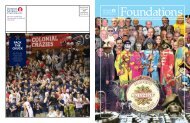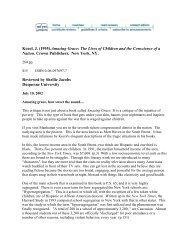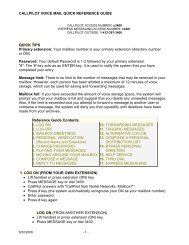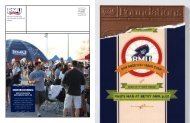1142 SOMOS® DMX-SL 100 (English) aaa COMMERCIAL MSDS ...
1142 SOMOS® DMX-SL 100 (English) aaa COMMERCIAL MSDS ...
1142 SOMOS® DMX-SL 100 (English) aaa COMMERCIAL MSDS ...
You also want an ePaper? Increase the reach of your titles
YUMPU automatically turns print PDFs into web optimized ePapers that Google loves.
Material Safety Data Sheet<strong>SOMOS®</strong> <strong>DMX</strong>-<strong>SL</strong> <strong>100</strong>1. Chemical Product and Company IdentificationTrade name : <strong>SOMOS®</strong>Chemical Family :CAS Number:Epoxy, acrylate, polyolIngredients not precisely identified areproprietary.Manufacturer : DSM Desotech Inc.1122 St. Charles StreetElgin IL 60120Tel: 847-697-0400Emergency telephone numberDSM Desotech: (847)697-0401 (During normal business hours)CHEMTREC (within the U.S.A.) : (800)424-9300 (24 hour)HazardousMaterialInformationSystem(U.S.A.)Health * 2Fire HazardReactivityPersonal Protection11AGCHEMTREC (International): (01)(703)527-3887 [USA] (24 hour)The PPE (Personal Protection Equipment)designation in the HMIS is provided for use byemployees at DSM Desotech sites only. Otherusers of this product are encouraged to evaluatethe hazards of the product and assign PPE thatis applicable to their specific situations.2. Composition/Information on IngredientsName CAS # % byWeightEpoxy(s) 15-60Polyol(s) 15-35Acrylate(s) 15-50Photoinitiator(s) 0.2-15Additive(s) 0-1diethylene glycol 111-46-6
4. First-Aid Measures----Skin ContactEye ContactInhalationIngestion::::After contact with skin, wash immediately with plenty of water. Wash gently and thoroughly the contaminatedskin with running water and non-abrasive soap.Check for and remove any contact lenses. In case of contact, immediately flush eyes with plenty of water for atleast 15 minutes. Get medical attention.Remove victim from area of exposure if possible. Allow the victim to rest in a well-ventilated area. Seekimmediate medical attention.Do not induce vomiting unless directed by a physician. Never give anything by mouth to an unconsciousperson. If large quantities of this material are swallowed, call a physician immediately. Loosen tight clothingsuch as a collar, tie, belt or waistband. If vomiting occurs, keep head lower than hips to help prevent aspiration.5. Fire Fighting MeasuresFlammability : Flammable in presence of open flames and sparks.Flash Points : CLOSED CUP: Higher than 93.3°C (200°F). (Pensky-Martens.)Extinguishing Media : SMALL FIRE: Use DRY chemical powder.LARGE FIRE: Use water spray, fog or foam. Do not use water jet.Special fire-fighting procedures : Fire fighters should wear positive pressure self-contained breathing apparatus(SCBA) and full turnout gear.Unusual fire/explosion hazards : In case of fire toxic fumes might be formed. In case of fire and/or explosion do notbreathe fumes. Containers may rupture from pressure build-up.Hazardous thermal (de)compositionproducts: POSSIBLE Products of Combustion: carbon oxides (CO, CO2), sulfur oxides (SO2,SO3). nitrogen oxides (NO, NO2...) Hydrogen Fluoride (HF) antimony oxidesProtection of fire-fighters : Be sure to use an approved/certified respirator or equivalent.Auto-ignition TemperatureLower explosion limit::Not determined.Not determined.6. Accidental Release MeasuresSmall spill and leakLarge spill and leak::Wear appropriate protective clothing to prevent skin contact. Wear appropriate respirator when ventilationis inadequate. Avoid breathing vapors of this product. Avoid contact with skin and eyes. Avoid allpossible sources of ignition (spark or flame). Keep unnecessary people away from spill area. Clean upspills immediately. Absorb with liquid-binding material (sand, diatomite, universal binders, or spill kit).Place in suitable clean, dry containers for disposal by approved methods.Do not clean-up or dispose except under supervision of a specialist. Eliminate all ignition sources. Forlarge spills dike spilled material or otherwise contain material to ensure runoff does not reach a waterway.Keep unnecessary people away from spill area. Follow company spill response procedures. Wearprotective eyeglasses or chemical safety goggles and face protection. Contact lenses are not protectiondevices. Appropriate eye protection must be worn instead of, or in conjuction with contact lenses. WearMSHA/NIOSH approved self-contained breathing apparatus or equivalent and full protective gear. Wearappropriate protective clothing to prevent skin contact. Place spilled material in an appropriate containerfor disposal. Dispose of according to all federal, state and local applicable regulations.7. Handling and StorageHandling :StorageOpen containers and handle under yellow light only. Keep away from heat. Keep away from sources ofignition. Eating, drinking and smoking should be prohibited in area where this material is handled, stored andprocessed. Keep away from incompatibles such as oxidizing agents. May react or be incompatible withacids. Do not breathe gas/fumes/vapor/spray. Use only with adequate ventilation. Avoid contact with eyes,skin and clothing. Wear appropriate protective clothing to prevent skin contact. After handling, always washhands thoroughly with soap and water. Avoid contact with spilled materials and runoff with soil and surfacewaterways.: Keep container tightly closed in a cool, well-ventilated place. Store between 15-30 o C. Keep away fromsources of ignition. Empty containers retain product residue and can be hazardous.<strong>SOMOS®</strong> <strong>DMX</strong>-<strong>SL</strong> <strong>100</strong> Version 1 Page Number: 2/5
8. Exposure Controls/Personal ProtectionOccupationalExposure LimitsacrylateManufacturer (United States, 2004). Notes: Based upon the physicalstate in which this raw material is supplied and the manner in which theproduct is applied, airborne exposure to this raw material is consideredunlikely to occur.TWA: 1 mg/m 3 Form: Respirable fractionACGIH TLV (United States). Notes: Based upon the physical state inwhich this raw material is supplied and the manner in which the productis applied, airborne exposure to this raw material is considered unlikelyto occur.TWA: 5 mg/m 3 Form: Dust.diethylene glycol AIHA WEEL (United States, 2001).TWA: 10 mg/m 3Antimony Compounds ACGIH TLV (United States, 2001).TWA: 0.5 mg/m 3NIOSH REL (United States, 2001). Notes: Note: The REL and PEL alsoapply to other Antimony compounds (as Sb).TWA: 0.5 mg/m 3 Period: 10 hour(s).OSHA PEL 1989 (United States, 1989).TWA: 0.5 mg/m 3Engineering Controls : Provide exhaust ventilation or other engineering controls to keep the airborne concentrations of vapors belowtheir respective threshold limit value. Ensure that eyewash stations and safety showers are proximal to thework-station location.Personal ProtectionVentilation : Good general ventilation should be sufficient to control airborne levels.Respiratory system :Skin Contact :Eyes :Other information :Wear appropriate respirator when ventilation is inadequate.Use chemical resistant, impervious gloves. ( Nitrile. ) Work uniform or laboratory coat.Safety glasses with side shields or chemical splash goggles.Wear nitrile or other chemical resistant gloves to avoid skin contact when handling partially cured fabricatedobjects in the "green" state of cure (after initial laser cure). The fabricated objects may be handled withoutgloves after the object has been thoroughly washed with solvent (ex. tripropylene glycol monomethyl ether,isopropyl alcohol) followed by post exposure to UV light and/or an oven bake at temperatures aboves 130 o C.When sanding fully cured surfaces, suitable respirator protection for dust should be used. Good generalventilation is required when tooling or sanding to avoid inhalation of particulate matter or airborne particles.Avoid sanding or finishing parts that are not fully cured, as uncured material may cause skin sensitization orrespiratory irritation.9. Physical and Chemical PropertiesPhysical State and AppearanceColorOdorBoiling PointVapor DensityEvaporation rate (butyl acetate = 1)::::::Liquid. (Viscous liquid.)OpaqueCharacteristic.Not determined.>1 (Air = 1)
10. Stability and ReactivityStabilityHazardous PolymerizationIncompatibility, Conditions to avoid,Materials to avoidHazardous Decomposition Products:The product is stable.: Not likely under normal conditions.::Keep away from direct sunlight or strong incandescent light. Keep away from heat.May react or be incompatible with acids. Incompatible with peroxides.Possibly hazardous short term degradation products are not likely. However, longterm degradation products may arise.11. Toxicological InformationRoutes of EntryToxicologicalInformationSkin, eyes and respiratory tract.Acute oral toxicity (LD50): >5000 mg/kg [Rat]. (acrylate).Acute dermal toxicity (LD50): >20 mg/kg [Rabbit]. (triethylene glycol).Remarks: Any information in this section is for component(s) contained in this product.Epoxy: Acute Toxicity:Peroral: rat; LD50 5000 mg/kg; approximatelyPercutaneous: rabbit; LD50 =>23000 mg/kgDevelopmental Toxicity:Did not cause birth defects in laboratory animals. Has been toxic to the fetus in lab animals at doses toxic tothe mother.Reproductive Toxicity:Limited data in laboratory animals suggest that the material does not affect reproduction.Chronic Toxicity and Carcinogenicity:Did not cause cancer in animal skin painting studies.Genetic Toxicology:In vitro: In vitro genetic toxicity studies were negative in some cases and positive in other cases.In vivo: Animal genetic toxicity studies were negative.Significant Data with Possible Relevance to Humans:In animals, effects have been reported on the following organs: Kidney, liver and upper respiratory tract.Epoxy Resin Mixture: Acute Effects:eye irritation: Draize - 2 (rabbit)skin irritation: Draize - 1.6 (rabbit)Chronic Health Effects:Carcinogenicity:Recent 2-year bioassays in rats and mice exposed by the dermal route to the component yielded no evidenceof carcinogenicity to the skin or any other organs. This study clarifies prior equivocal results from a 2-yearmouse skin painting study, which were suggestive, but not conclusive. for weak carcinogenic activity. TheInternational Agency for Research on Cancer (IARC) concluded that this component is not classifiable as acarcinogen (IARC group 3), that is human and animal evidence of carcinogenicity is inadequate.Mutagenicity:Similar resins have proved to be inactive when tested by in vivo mutagenicity assays. These resins haveshown activity in invitro mircobial mutagenicity screening and have produced chromasomal aberrations incultured rat liver cells.acrylate: A 13-week inhalation study in rats of a compositionally similar acrylic powder showed inflammatoryeffects in the lung at concentrations of 6 mg/m3 for 6 hours per day, 5 days per week. These findings wereconsistent with high concentration exposure effects reported for other non-soluble dusts such as titaniumdioxide and toner. Maintaining airbone dust concentrations within the recommended exposure limit is notexpected to produce adverse effects within the lung.diethylene glycol: There is a marked difference in the acute oral toxicity of this material between animals andman. Man is much more susceptible than animals. The estimated fatal dose for man is 1.2 mg/kg (<strong>100</strong> mL or1/2 cup for a 82 kg or 180 lb man).Photoinitiator: This material was mutagenic in the Ames bacterial assay. It is inactive, however, in the in vivomouse micronucleus test.Chronic effects onhumansCARCINOGENIC EFFECTS: Classified None. by IARC, None. by OSHA, None. by NTP [<strong>SOMOS®</strong> <strong>DMX</strong>-<strong>SL</strong><strong>100</strong>].Remarks: Any information contained in this section is for component(s) contained in this product.Not available.<strong>SOMOS®</strong> <strong>DMX</strong>-<strong>SL</strong> <strong>100</strong> Version 1 Page Number: 4/5
Acute effects onhumansMay cause skin, eye and respiratory irritation. Avoid prolonged or repeated contact with skin. May cause skinsensitization.Remarks: Any information in this section is for component(s) contained in this product.Eating, drinking and smoking should be prohibited in area where this material is handled, stored andprocessed. Workers should wash hands and face before eating, drinking and smoking.12. Ecological InformationNot available.13. Disposal ConsiderationsWaste Disposal : This material and its container must be disposed of in a safe and environmentally responsible way. Wastemust be disposed of in accordance with federal state and local environmental control regulations. Do notallow product to reach sewage system /surface or ground water.14. Transport InformationNot available.15. Regulatory InformationFederal and State RegulationsU.S. Federal Regulations : All the ingredients are on the TSCA list.SARA 313 toxic chemical notification and release reporting: Antimony Compounds 1.7%State Regulations :California prop. 65This product contains or may contain trace quantities of a substance(s) known to the state ofCalifornia to cause cancer, birth defects or other reproductive harm.Pennsylvania RTK , Massachusetts RTK , New Jersey RTKPennsylvania RTK: diethylene glycol: (generic environmental hazard); triethylene glycol: (genericenvironmental hazard); Antimony Compounds: (environmental hazard, generic environmentalhazard)Massachusetts RTK: diethylene glycol, Antimony CompoundsNew Jersey RTK: diethylene glycol, Antimony CompoundsSee section 2 for additional composition information16. Other InformationOther Special Considerations: Not available.<strong>MSDS</strong># : 015756Date of issueNotice to Reader: 3/1/2007.To the best of our knowledge, the information contained herein is accurate. However, neither DSM Desotech nor any of its affiliates assumes any liability whatsoever forthe accuracy or completeness of the information contained herein. While this information has been prepared in good faith by technical experts within the Desotechorganization, the final determination of suitability of any material is the sole responsibility of the end user, after proper consultation with the end users' engineering,technical, health and safety professionals. All materials may present unknown hazards and should be used with caution considering the specific material, other materialsthat it may or may not be combined with, and any engineering controls and/or process implementation(s) designed for the use of the material in any specific systemprocess. Although certain hazards are described within, these cannot be guaranteed as the only hazards that exist. This Material Safety Data Sheet (<strong>MSDS</strong>) has beenprepared in accordance with the requirements of the OSHA Hazard Communication Standard (29 CFR 1910.1200).<strong>SOMOS®</strong> <strong>DMX</strong>-<strong>SL</strong> <strong>100</strong> Page Number: 5/5
















